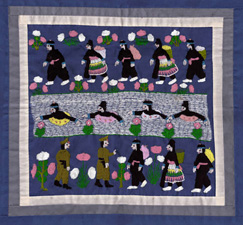recent arrivals
The Hmong Story Cloth
By 2006, Asians comprised the fastest growing minority population in the Valley, with much of this growth in the Vietnamese community in Hampden County, which includes the cities of Springfield, West Springfield, Chicopee and Agawam.
Many Vietnamese in the Valley are not immigrants but refugees who fled their homeland at the end of the Vietnam War, which also involved Cambodia and Laos in Southeast Asia. Significant numbers of Cambodian and Laotian refugees have also been drawn to the Valley to join the growing Southeast Asian population. Even within this population, however, there are distinct language groups, religious practices and ethnic identities. One example of a local Asian population with distinctive cultural traditions is the Hmong.
The Hmong migrated in the nineteenth century from southern China to the highlands of Vietnam and Laos. During the 1960s and 1970s, the United States government enlisted Hmong collaborators in the war that was spreading from Vietnam into Laos and Cambodia. After the U.S. pulled out its troops in 1975, many Hmong fled to refugee camps in Thailand, from which many then relocated to the U.S., France, Australia and Canada.
Hmong refugees brought with them a rich tradition in textile arts. The practice of making paj ntaub , or "flower cloth," has long been revered among the Hmong, and was used as a means of preserving oral traditions and communal identity when the Hmong language was suppressed by the Chinese. Brightly colored, intricately hand-stitched geometric patterns adorned garments created for special occasions, such as births, weddings, and funerals — each occasion distinguished by particular symbols and colors. Creation of the cloths by women and girls, sitting together in circles outside of homes, also served to transmit the necessary skills across the generations. The traditional designs can be seen today in the Connecticut River Valley on baby carriers, jackets, aprons and quilts.Another form of artistry in needlework, paj ntaub dab neej (flower cloth of people and customs) or "story cloth," developed as a means of preserving and recording stories and experiences of the Hmong people. These embroidered wall hangings depict village life; also images of war, refugee camps, and escape. The story cloths serve as an extension of the Hmong oral tradition, and as a form of cultural expression and communal memory during a period of traumatic displacement and adjustment.
The story cloth shown here was made by a Springfield Technical Community College student who as a young girl lived in a Thai refugee camp for two years before coming to western Massachusetts in the early 1980s.